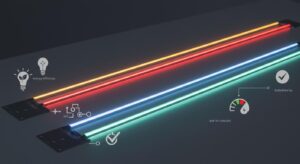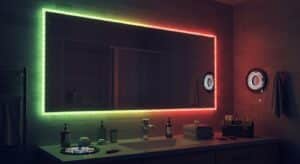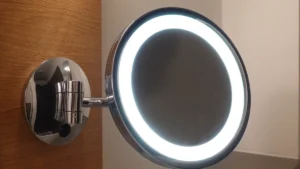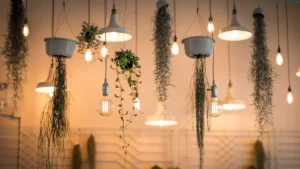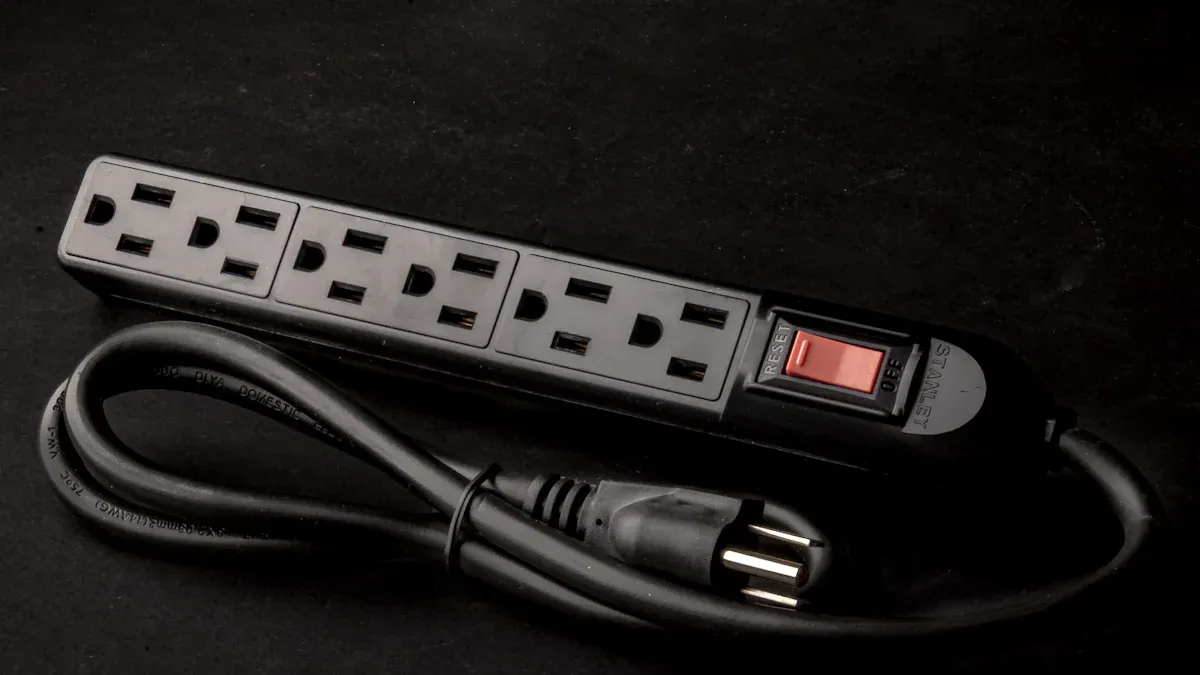
Accurately figuring out the power needs of your 2835 LED strip is important. It helps save energy and keeps the lights working well. If you don’t calculate correctly, you might overload the power supply. This could also make the lights dim or wear out faster. For instance, a 5-meter 2835 LED strip uses about 45–50 watts. That’s less energy than one regular incandescent bulb. These LED strips can last up to 50,000 hours. This is much longer than the 1,000 hours of old-style bulbs. By knowing things like wattage per meter, strip length, and voltage, you can make your setup work better and last longer.
Key Takeaways
Find out how many watts your 2835 LED strip uses per meter. Most strips use about 9-10 watts per meter. This tells you how much power you need.
Make sure the voltage of your power supply matches your LED strip. The right voltage stops overheating and damage.
Follow the 80% rule for picking a power supply. Divide the total watts by 0.8. This ensures the power supply can handle the load safely.
Add extra power to your calculations for safety. This avoids overheating and helps your LED setup last longer.
Pick good-quality LED strips and power supplies. Better products work well, last longer, and save you money over time.
Key Factors Influencing 2835 LED Strip Wattage
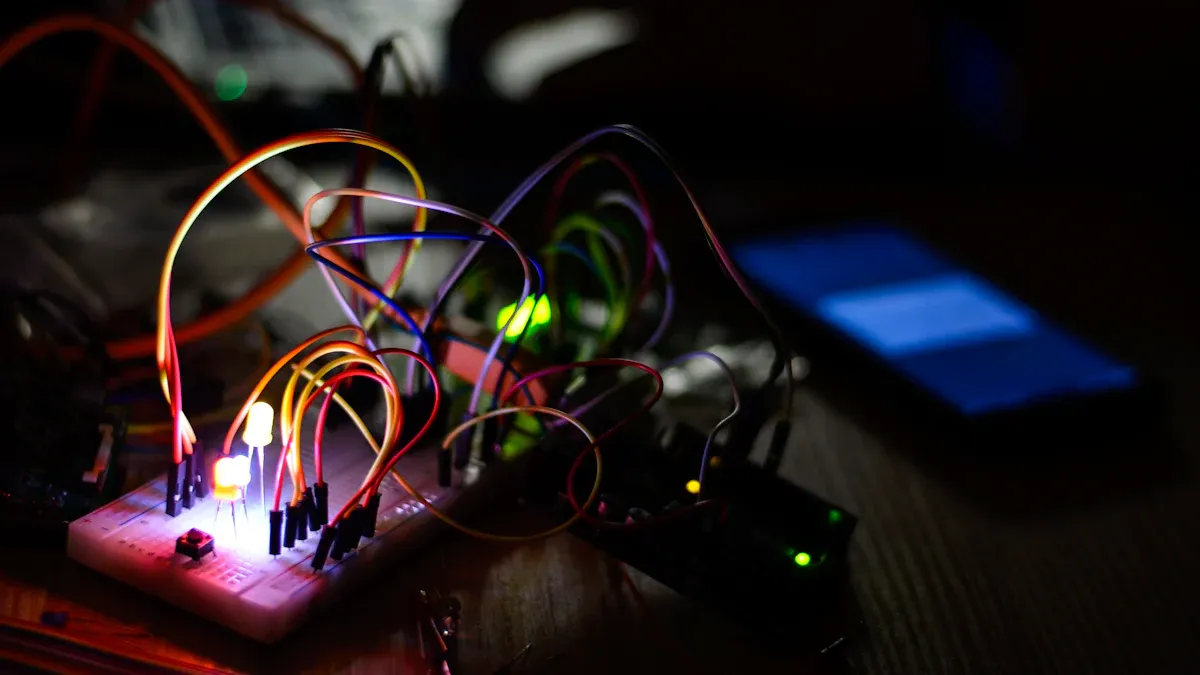
Understanding Wattage per Meter
Wattage per meter is key to knowing power needs. Most 2835 LED strips use 9–10 watts per meter. Some high-quality strips use up to 15 watts per meter. These brighter strips need more power. LED density and color temperature also affect wattage. Strips with more LEDs or warmer colors use more energy. Always check the manufacturer’s details for wattage per meter.
The Role of Voltage in Power Consumption
Voltage affects how much power LED strips use. Most 2835 strips run on 12V or 24V DC. The 12V option is more common. Voltage doesn’t change brightness but must match the power supply. Wrong voltage can cause damage or waste energy. Longer strips may lose voltage, lowering power use per meter. Always check the strip’s voltage and current ratings to avoid problems.
Calculating Power Based on Strip Length
To find total power use, multiply wattage per meter by strip length. For example, a 10-watt strip that’s 5 meters long uses 50 watts. Use the 80% rule to pick a power supply. Divide total power by 0.8 to find the minimum supply size. A 50-watt strip needs at least a 62.5-watt power supply. This prevents overloads and helps your lights last longer.
Step-by-Step Guide to Calculating Power Needs
Find Out the Wattage per Meter
First, check how many watts your LED strip uses per meter. You can find this information from the manufacturer. For example, most 2835 LED strips use about 10 watts per meter. Some brighter strips may use up to 15 watts per meter. The number of LEDs and their brightness can change this value. A wattage chart can also help you estimate. For example:
LED Strip Length | Watts Used per Meter |
|---|---|
1 meter | About 15 W |
2 meters | About 30 W |
5 meters | About 75 W |
Knowing this helps you figure out total power use.
Measure the LED Strip’s Length
Next, measure how long your LED strip needs to be. Use a tape measure to check the area where you’ll place it. If the strip will bend or turn, include that in your measurement. For longer strips, voltage drop might make the far end dimmer. Manufacturers often list the longest strip length allowed to avoid overheating. Many 2835 LED strips can go up to 5 meters per segment.
Multiply Length by Wattage per Meter
Now, multiply the strip’s length by its wattage per meter. For example, if your strip uses 10 watts per meter and is 5 meters long, the total power is:
10 watts/meter x 5 meters = 50 watts
Use the 80% rule to pick a power supply. Divide the total power by 0.8 to find the smallest power supply you need. For a 50-watt strip, get a power supply of at least 62.5 watts. This keeps the strip from overheating and helps it last longer.
Add a Safety Margin to Your Calculation
Adding a safety margin helps your LED strip work better. It also makes the setup last longer. Without it, the power supply might overheat or fail early. A safety margin gives extra room for unexpected power changes.
Why a Safety Margin is Important
Power supplies work best when not used at full capacity. Running at 100% can lower efficiency and shorten their life. Adding a safety margin reduces stress and makes the system more reliable.
Steps to Add a Safety Margin
Follow these steps to include a safety margin:
Find Total Power Needs: Multiply the wattage per meter by the strip’s length. For example, a 10-watt-per-meter strip that’s 5 meters long uses 50 watts.
Use the 80% Rule: Divide the total power by 0.8 to find the smallest power supply size. Using the example:
50 watts ÷ 0.8 = 62.5 wattsThis means you need a power supply of at least 62.5 watts.
Tip: Always round up to the next available power supply size. If your result is 62.5 watts, pick a 70-watt or 75-watt power supply.
Benefits of Adding a Safety Margin
Stops overheating and helps the power supply last longer.
Keeps performance steady, even if power needs change.
Allows room for future upgrades, like adding more LED strips.
By using a safety margin, you protect your setup and make sure it works well for a long time.
Choosing the Right Power Supply for Your LED Strip 2835
Matching Voltage and Current Ratings
To make your LED strip 2835 work well, match its voltage and current needs with the power supply. Most LED strips use 12V or 24V. Always check the strip’s details to confirm the correct voltage. Using the wrong voltage can harm the strip or shorten its life.
The current the strip uses is also important. For example, a strip with 3.0V might use 120mA, while one with 3.2V might use 200mA. Make sure the power supply can handle the total current the strip needs.
Voltage (V) | Current Draw (mA) |
|---|---|
2.5 | Very low |
3.0 | 120 |
3.2 | 200 |
Selecting a Power Supply with Enough Capacity
Pick a power supply with enough capacity for steady performance. First, find out how much power your LED strip uses. Multiply the strip’s wattage per meter by its length. For example, if the strip uses 14 watts per meter and is 8.5 meters long, it needs 119 watts. Add at least 20% more as a safety margin. In this case, you’d need a 150-watt power supply.
The power supply must also change AC to low voltage DC properly. A weak power supply might overheat or stop working early. For instance, a strip using 5.5 watts per foot and 32.8 feet long would need at least 216.5 watts to work well.
Criteria | Explanation |
|---|---|
Voltage Compatibility | Make sure the power supply’s voltage matches the LED strip’s voltage (12V or 24V). |
Watts Per Meter | Calculate total power needed (e.g., 14W/m for 8.5m = 119W) and add 20% more (e.g., 150W). |
Length of LED Tape | Longer strips need more power; choose the right supply to avoid problems. |
Thinking About Dimmable and Non-Dimmable Options
Decide if you need a dimmable power supply. Dimmable supplies let you change the brightness of your LED strip. They use technologies like PWM (Pulse Width Modulation) or TRIAC dimming. But they might need special conditions to work well.
Non-dimmable power supplies are simpler and usually cheaper. They give steady brightness but can’t adjust light levels. If you want your LED strip for decoration or mood lighting, a dimmable supply might be worth it.
Consideration | Dimmable Power Supply | Non-Dimmable Power Supply |
|---|---|---|
Dimming Capabilities | Can adjust brightness with PWM or TRIAC | No brightness control |
Efficiency | Works best with 80% or higher efficiency | Efficiency may vary |
Environmental Factors | Needs specific conditions for dimming | Easier to use in most setups |
By looking at these points, you can pick a power supply that fits your LED strip 2835 and keeps it running smoothly.
Practical Tips for Optimizing Energy Efficiency
Use the Correct Voltage for Your LED Strip
Matching the voltage is key for your LED strip to work well. Always use a power supply with the same voltage as your LED strip. For example, if your strip needs 12V, the power supply must also give 12V. Using the wrong voltage can cause overheating or damage.
The right voltage keeps the strip bright and saves energy. It also helps the LEDs last longer. If you don’t know the voltage, check the manufacturer’s details or ask an expert. Even small voltage changes can affect how the strip works.
Tip: Pick a power supply made for LED strips to avoid problems.
Avoid Overloading the Power Supply
Overloading the power supply can make it overheat or stop working. To avoid this, calculate how much power your LED strip uses. Then, choose a power supply with more capacity than needed. For example, if your strip uses 50 watts, get a power supply with at least 62.5 watts.
Using a power supply at full capacity all the time can wear it out faster. Leaving extra room helps it last longer and lets you add more strips later. A properly sized power supply keeps your lights safe and efficient.
Note: Overloading can cause fires or system failures, so safety is important.
Consider Using Timers or Dimmers
Timers and dimmers help save energy with your LED strips. Timers let you set when the lights turn on and off. For example, you can turn them off during the day or when no one is in the room.
Dimmers let you change the brightness to fit your needs. Lower brightness uses less power and makes the LEDs last longer. This is great for mood lighting or decorations.
Pro Tip: Use dimmers with motion sensors to save even more energy. This way, lights only turn on when needed.
Choose High-Quality LED Strips and Power Supplies
Picking high-quality LED strips and power supplies is important. They help your lights work well and last longer. Cheap products can break quickly, costing more to replace. Good-quality parts save you money and give steady performance.
Top-quality LED strips are made with strong materials like double-layer pure copper PCBs. These materials help get rid of heat, stopping the strips from overheating. Managing heat properly makes the strips last longer and work better. Trusted brands also test their LED strips to meet high standards.
Tip: Check for certifications like UL, ELT, CB, or CE. These prove the product is safe and works well.
Factor | What It Means |
|---|---|
Materials | Strong materials like double-layer pure copper PCBs are used. |
Heat Management | Good heat control keeps the LED strips reliable and long-lasting. |
Certifications | Look for safety and quality certifications like UL, ELT, CB, or CE. |
Lifespan | High-quality products can last 50,000 hours or more. |
Good power supplies are just as important. They change AC to DC power and keep voltage steady. This stops flickering and protects your LED strips from damage.
High-quality parts are tested to make sure they last and work well. Certifications like LM80 and LM70 show the LEDs stay bright and efficient over time.
Pro Tip: Don’t buy products without certifications or test reports. They might be cheaper but will cost more to replace often.
By choosing high-quality LED strips and power supplies, you get a safe, efficient, and long-lasting lighting system.
Knowing the wattage, voltage, and length of your LED strip is important. These details affect how much energy it uses and how long it lasts. To find total power, multiply the strip’s length by its watts per meter. Add at least 10% extra power for safety. This helps the system work well and last longer. Planning carefully saves energy and keeps your lights running smoothly. Follow these steps to build a strong and efficient lighting setup that fits your needs.
FAQ
What is the difference between 12V and 24V LED strips?
12V LED strips are more common and suitable for shorter lengths. 24V strips handle longer runs with less voltage drop. Choose based on your project size. For example, if your strip exceeds 5 meters, 24V is better to maintain brightness across the entire length.
How do I prevent voltage drop in long LED strips?
To prevent voltage drop, use a 24V LED strip or add power injection points along the strip. Shorten the strip length if possible. Always check the manufacturer’s guidelines for maximum run length to ensure consistent brightness.
Can I connect multiple LED strips to one power supply?
Yes, but ensure the power supply has enough capacity. Add the total wattage of all strips and include a 20% safety margin. For example, if two strips use 50 watts each, choose a power supply rated for at least 120 watts.
Do I need a dimmer for my LED strip?
A dimmer is optional but useful. It lets you adjust brightness, saving energy and extending the strip’s lifespan. Use a compatible dimmer with your power supply and LED strip for the best results.
How do I know if my power supply is compatible?
Check the voltage and wattage requirements of your LED strip. Match the voltage exactly (e.g., 12V strip needs a 12V power supply). Ensure the power supply’s wattage exceeds the strip’s total wattage by at least 20% for safety.
Tip: Always verify compatibility with the manufacturer’s specifications.
See Also
Comparing SMD 2835, 5050, And 3528 LED Strips
Choosing The Perfect LED Strip Lights For Linear Lighting
A Comparison Of High-Brightness LED Strips For All Uses
Effective Installation Tips For RGB LED Strip Lights
Selecting The Ideal RGB+W COB LED Strip For You
